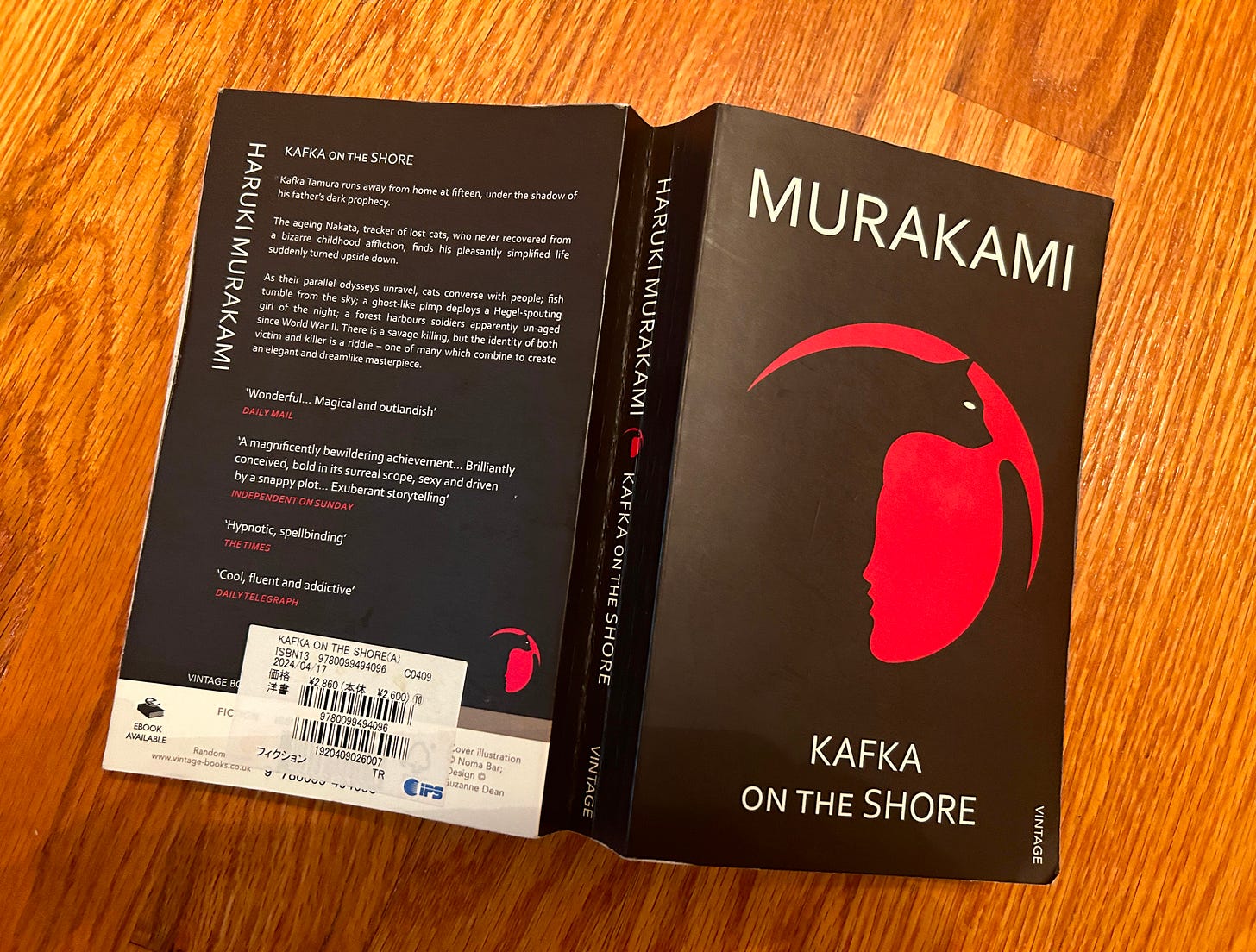An extended summary of Kafka on the Shore (a magical realism novel wherein we find the main character has an Oedipus complex) in three parts.
The three stories
Kafka on the Shore is a story of a boy, Kafka Tamura. The narrative opens with Kafka in his father’s study talking with a boy named Crow. They are beside each other plotting how Kafka will run away from home on his 15th birthday; they discuss what money he will need, and where he might get it—he steals it from his father among other items. He leaves his father’s Sea Oyster Rolex, “Something flashy will only attract attention.”
By chapter six, three stories emerge: the main story with Kafka, the subordinate story with Mr. Nakata, and an auxiliary story explaining, through a top secret US Department of Defense document, an incident in the forested hills in Yamanashi where 16 elementary school students, out on a field trip with their teacher to collect mushrooms to supplement World War II rations, collapsed en masse.
While the group were in a clearing in the forest, a high flying shiny object flew over them. They all thought it was a B2 Bomber, but the US Military has no records of planes in the area at the time. Beneath the flying object, the students carry on foraging. The teacher asks that they get in groups and go find mushrooms in the forest.
Soon the teacher notices three students collapsed. She examines them—they seem in a deep peaceful sleep. They are not in any distress. She looks for the fastest runner to send for help, but all other students have collapsed too. Left with no choice, she leaves the students and goes down the mountain to get help. The students are carried down to their school. They are examined and tested by experts, with mushroom poisoning thought to be the likeliest cause, but no diagnosis is ever established. In time, all the students make full recoveries, except one—this student grows up to be Mr. Nakata.
The auxiliary story explains Mr. Nakata; it explains his limited ability to understand and navigate the world why he only has half of his shadow, his ability to talk to cats, why he considers himself dumb and others think him unusual, and why he survives on subsidies from the mayor and not on a regular job.
Although Mr. Nakata and Kafka both live in Nakano ward in Tokyo, they don’t know each other, but events link them to each other. They are each driven by a mysterious force toward fulfilling preordained life outcomes. When he leaves Nakano, Mr. Nakata travels the same route to Takamatsu as runaway Kafka—Mr. Nakata hitchhikes; Kafka takes a bus, and on the bus we start to know Kafka better.
Kafka Tamura
Kafka has an older sister adopted by his parents before he is born. His mother abandons four-year old Kafka and his father. She takes his older sister with her. In the present, Kafka lives in a house with his estranged father a life of mutual avoidance; each going about his business not caring what the other is up to.
Kafka runs away to Takamatsu in Shikoku. He believes 15 years is the ideal age to run away; it is not too soon nor too late. The boy named Crow is his inner voice, his inner devil’s advocate. Crow makes genie-like appearances at critical points when Kafka must settle important questions. Crow is counselor, admonisher, encourager, etc., just the thing a teenager runaway needs to steady his nerves.
On the day he runs away, Kafka meets three people: Sakura, Oshima and Miss Saeki—they shape his sojourn as a runaway. On the bus to Takamatsu, he meets Sakura.
Sakura
Kafka and Sakura, both headed to Takamatsu on a bus, meet and start talking at a rest stop. When they re-board the bus, Sakura asks to sit next to Kafka. She fears a weirdo might plop next to her if she sat by herself on a double seater. Strangers disconcert her such that she can’t sleep. She wants some sleep before getting to Takamatsu. Seated next to Kafka, Sakura sleeps. Kafka steals amorous glances at the sleeping Miss, and imagines. In this state, he theorizes Sakura could be his lost older sister: she is the right age, and has a brother about his age who she has not seen in a long time. But Kafka knows it's a longshot theory.
In many ways Sakura is like Kafka. She does not get along with her parents, she stole money from them, tried to run away to Hokkaido, and she hates school. They are friends by the time they get to Takamatsu. Sakura gives Kafka her number to call if he ever needs something. Eight days later, he calls.
Oshima
The morning Kafka arrives in Takamatsu, on a Tuesday, he meets Oshima at a private library where Kafka goes to while away the day reading before checking into his hotel for his first night alone away from home. He is a bookworm; he has loved libraries since he was little. For a truant 15-year old at large, reading in a library during school hours is the surest way to allay the suspicions of nosy adults. The library is the Komura Memorial Library—Oshima works there at the front desk.
Oshima is a woman who presents and lives as a man. He takes Kafka under his wing. From their first exchange, Oshima is a wary, wise older brother to Kafka’s tough yet venerable precocious little brother. Oshima tells Kafka the library, “Specializes in certain genres of books, mainly old books by tanka and haiku poets.” And, “No one comes to the library to read the latest Stephen King novel.”
That Tuesday afternoon, the Head Librarian Miss Saeki, gives a tour of the library as was her custom. Miss Saeki is Oshima’s boss.
Miss Saeki
Kafka and a couple from Osaka take the tour. Miss Saeki makes a strong impression on Kafka. She is “stunning,” says Oshima of Miss Saeki. Wistful and nostalgic, Kafka wishes Miss Saeki were his mother—the same thoughts he has of any charming middle-aged woman he meets. But as long as he doesn't know his real mother, there is a remote chance Miss Saeki could be his mother. It is a sweet thought.
Growing up, Miss Saeki is a classmate of Oshima’s mother (that is how he gets the job at the library); very capable in the arts, sports, and gets excellent grades. In school she has a sweetheart, the oldest son of the Komura family, the patrons of the library. Miss Saeki and the Komura boy make a handsome couple, and are rarely apart. But when her lover leaves her (her parents would not let her leave Takamatsu), and departs for Tokyo, partly because he wants to explore, partly to test their love, a distraught Miss Saeki pens a poem, and sets it to piano music. The poem gets out to the world as a song she professionally records. It plays all over the radio and sells more than one million records. The song is titled Kafka on the Shore—it is not Kafka Tamura, but Miss Saeki’s song, her grieving song, that gives the title to the novel.
Her lover dies a pointless death at university in Tokyo at age 20. He is tortured and beaten to death by fellow students who mistake him for a leader of the opposition during a period of unrest. Miss Saeki disappears from Takamatsu. Rumors fly that she attempted suicide near mount Fuji, that she was spotted in Tokyo and has become a writer, that she is married and has child—no one is sure what happened to Miss Saeki for over 20 years. As an only child from a well-to-do family, and receiving royalties for her hit song, it is easy to disappear and stay hidden.
She never records another song.
She reappears in Takamatsu to take care of things after her mother’s death; then she becomes head of the Komura Library, but lives an unhappy life. Kafka suspects Miss Saeki only came back to Takamatsu to be head of the Komura Library. Her mother’s death only set her off to make the move.
Miss Saeki is unhappy as an adult, but the genesis of her unhappiness goes back to when, as a 15 year old, she comes across a stone that sets into motion events that affect the lives of a boy named Saturo Nakata, and others.
Mr. Saturo Nakata
After the Yamanashi incident, the boy Nakata remains in a peaceful sleep. He is moved to a better hospital in Tokyo. For three weeks he remains asleep, confounding experts. One day he wakes up from the deep sleep on his own.
He grows up to be a simple man. His memory of his past before the incident is erased. It leaves him unable to read or write or understand and make sense of everyday things such as money, hold regular jobs or form or need intimate relationships. He learns rote carpentry and does it proficiently once he gets it—he works at a small furniture factory for 37 years. He also develops supernatural powers; he can talk with cats, foretell or cause the heavens to send showers of leeches or fish at a particular place.
Mr. Nakata lives a contented life in Nakano ward, never straying outside of its boundaries until Johnny Walker upends it when he goads Mr. Nakata to murder him.
Johnny Walker
Mr. Nakata is picked up and lead from a vacant lot, where he is on a stakeout for Goma, a missing cat he is asked to find(since he talks to cats, he is good at finding cats) for a family and their daughters, by a big black dog and taken to Johnny Walker’s house. Johnny Walker is a catnapper who rips hearts out of paralyzed, but conscious cats. He eats the little hearts as they still beat, wiping blood from his mouth with the back of his palm. He makes special flutes out of the souls of the cats. After killing three other cats with Mr. Nakata watching, Mr. Nakata, blind with rage, stabs him to death when he moves to kill Goma and Mimi-–he knows Mimi from inquiring about Goma in the vacant lot.
Mr. Nakata hits the road
The evening he kills Johnny Walker, Mr. Nakata wakes up in the night in the vacant lot he was on a stakeout for Goma. He remembers killing Johnny Walker, and getting bloody, but to his surprise his clothes are clean—no drop of blood. It is as if he fell asleep and had a bad dream. But it is no dream. Grateful Goma and Mimi, rescued from Johnny Walker, are now licking his confused face. And Mr. Nakata finds he does not understand what Goma and Mimi are saying. He can no longer talk with cats.
Mr. Nakata reports his murder of Johnny Walker to a dubious patronizing young police officer who does not even record his details; Mr. Nakata has very clean clothes for someone who just committed a bloody murder. Mr. Nakata decides to leave Nakano. He hitchhikes on long haul trucks. He only knows he must go west, but he does not know where he is going or how to get there.
Mr. Nakata’s travel retraces Kafka’s travel from Nakano to Takamatsu. Several people help Mr. Nakata on the way. Hoshino, a truck driver in his twenties delivering furniture to Kobe, picks Mr. Nakata at a truck stop. In Kobe, Mr. Nakata tells Hoshino he does not know where he is going, but he knows he must cross a big bridge. To Hoshino this means Mr. Nakata is going to Shikoku—Mr. Nakata must cross one of the big bridges from Honshu to Shikoku. But it puzzles Hoshino that Mr. Nakata does not know where he is going, or why he must go.
Hoshino
Not only does Hoshino give Mr. Nakata a lift to Kobe, he takes vacation to go to Shikoku with Mr. Nakata. Hoshino has never been to Shikoku, but also wants to help Mr. Nakata, who reminds him of his grandpa, navigate because Mr. Nakata can’t read.
Hoshino is an unremarkable ex-military young man with the usual attitudes and interests of men his age. He is a fan of the Chunichi Dragons, a top baseball team in Japan. Over about ten days, Hoshino becomes a friend, a believer in the enigmatic person and mystifying mission of Mr. Nakata. He becomes a convert of a sort. Mr. Nakata is simple yet inspirational, and deeply philosophical in his unusual speech. He has superpowers, and on a mission driven by forces unknown to him or anyone else. This is a mission he cannot explain to himself or anyone else except he must move in a certain direction. What his mission is will become apparent as he progresses.
In Takamatsu, over an udon lunch, it comes to Mr. Nakata that he is looking for the entrance stone. Here they get help from Colonel Sanders.
Colonel Sanders
Colonel Sanders, is a spirit insensate being. He has no name or shape; he has simply taken on the appearance of the fried chicken Colonel Sanders for the time being; he is neither God nor Buddha; good or evil hold no meaning for him, and he only “cares about consummating his function.” Sanders accosts Hoshino on a street as Hoshino walks Takamatsu to avert cabin fever. He pimps a beautiful girl to Hoshino. A reluctant Hoshino goes along with the scheme. Sleeping with the girl is just part of the formality, according to Sanders. It is a reward for Hoshino because Sanders himself has no substance, and to perform a real act, he needs someone of substance, the act is to carry the entrance stone to Mr. Nakata. Sanders knows where to find it.
Hoshino and Sanders locate the entrance stone at a small dilapidated shrine at the end of a path through the woods. Hoshino opens the door of the shrine to get to the stone. The stone is about the size of a big rice cake, white and smooth. Sanders orders Hoshino to take it. Hoshino protests, fearing a curse, though he takes the stone. He gets to the inn around 1am, and puts the stone next to Nakata’s pillow. Mr. Nakata wakes up to find the stone next to him.




